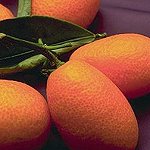|
|
|
Kumquat Fruit Facts Page Information
|
Availability by variety
|
 Kumquat, common name for small evergreen shrubs of a genus of the rue family,
and for the edible fruits produced by these shrubs. They are closely related to
plants of the citrus genus. Native to China and Indochina, the shrubs are
extensively cultivated in Japan and in the United States in Florida and
California.
Kumquat, common name for small evergreen shrubs of a genus of the rue family,
and for the edible fruits produced by these shrubs. They are closely related to
plants of the citrus genus. Native to China and Indochina, the shrubs are
extensively cultivated in Japan and in the United States in Florida and
California.
The two principal species are the round kumquat, which bears a globular fruit,
and the oval kumquat, which bears an elliptical fruit. Fruits of both species
are sweet and palatable and grow about as large as a small plum.
Both species of kumquat are fairly hardy and are grown as ornamental tub plants
in the northern United States and as outdoor plants in the southern United
States. Commercial kumquats are usually hybrids between species of the kumquat
genus and species of the citrus genus. They are frequently preserved in syrup
and eaten as dessert.
The kumquat is a sweet/sour fruit and is a member of the citrus family. The
majority of Kumquats in the United States are grown in California and
Florida. The kumquat is a delicacy whether eaten fresh or preserved. With a
thick sweet peel and a tart pulp, it is eaten slain and all. (Except for the
seeds) It is also a favorite for jellies, marmalade and crystallizing. Its
unique flavor lends itself as a pleasant addition to many dishes, desserts and
salads.
Basic Nutritional Facts:
· Lo Calories
· Lo Carbohydrates
· No Fat
· No Sodium
· Source of Potassium 185mg
· Source of Vitamin A 285iu
· Source of Vitamin C
Detailed nutritional informatin can be found by searching the
USDA Nutritional Database
. Enter "Kumquat" (no quotes) as the keyword and select the link and report of
interest.
Scientific classification:
Kumquats make up the genus Fortunella of the family Rutaceae. The round
kumquat is classified as Fortunella japonica and the oval kumquat as
Fortunella margarita.
|
|